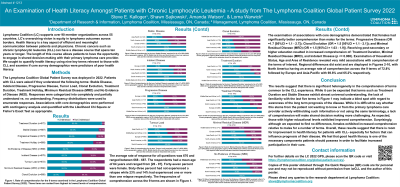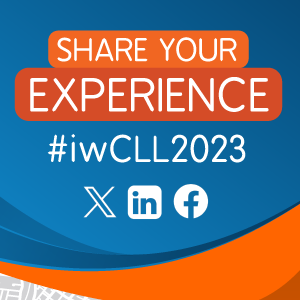Category: General Abstract
1213 - An examination of health literacy amongst patients with Chronic Lymphocytic Leukemia- A study from The Lymphoma Coalition Global Patient Survey 2022.

Introduction:
Health literacy is a key aspect of efficient and meaningful communication between patients and physicians. Chronic cancer’s such as chronic lymphocytic leukemia (CLL) can have a disease course that spans 10 years or longer. The length of this course allows patients to have the opportunity to engage in shared decision-making with their primary lymphoma care providers. We sought to quantify heath literacy using nine key terms relevant to those with CLL and examine if core survey demographics were predictors of poor health literacy.
Methods:
The Lymphoma Coalition Global Patient Survey was deployed in 2022. Patients with CLL were asked if they understood the following terms: Stable disease, Indolent disease, Progressive disease, Tumor load, Clonal evolution, Treatment duration, Treatment holiday, Minimum residual disease (MRD) and No evidence of disease (NED). Responses were categorized into completely and partially understand vs. no understanding. Frequency distributions were used to enumerate responses. Associations with core demographics were performed with contingency analysis and quantified with the Likelihood Chi Square or Fisher’s Exact Test as appropriate.
Results:
The average rate of response for all questions was 676 and ranged between 668 - 687. The respondents had a mean age of 64 years and ranged from [26 - 97]. Forty-seven percent were female. Sixty-three percent had not experienced a relapse while 23% and 14% had experienced one or more than one relapse respectively. The frequencies of comprehension across the 9 terms are shown in Table 1. The examination of associations with core demographics demonstrated that females had significantly better comprehension than males for the terms: Progressive Disease (OR =1.7 [95%CI = 1.1 - 2.7]); Clonal Evolution (OR = 1.5 [95%CI = 1.1 - 2.1]); and Minimal Residual Disease (MRD) (OR = 1.5 [95%CI = 1.03 - 1.9]). Receiving post-secondary or higher education resulted in increased comprehension of: Treatment Duration, Minimal Residual Disease (MRD), and Indolent Disease (p <= 0.008). Examination of Household Status, Age and Area of Residence revealed very mild associations with comprehension of the terms of interest. Regional differences did exist and are displayed in Table 2, with North America having an average rate of comprehension across the 9 terms of 72.8% followed by Europe and Asia-Pacific with 69.8% and 65.2% respectively.
Conclusion
The results suggest that there is significant heterogeneity in the comprehension of terms common to the CLL experience. While it can be expected that terms such as Treatment Duration and Stable Disease to exhibit almost universal understanding, the lack of familiarity with the last five terms in Table 1 may indicate a blind spot with regard to awareness of the long term prognosis of the disease. While it is difficult to say whether this stems from the patient not wanting to know, from primary lymphoma care providers using other terminology or actively withholding such information, a lack of comprehension will make shared decision making more challenging. A limitation of our study is that the terms we selected to reflect health literacy may not reflect the medical vernacular of various geographic regions. As expected, those with higher educational levels exhibited improved comprehension. Surprisingly, although we expected to find no differences, females exhibited increased comprehension relative to males for a number of terms. Overall, these results suggest that there is room for improvement in health literacy for patient’s with CLL- especially for factors that can influence prognosis of their disease. We feel that good health literacy is one of the necessary components patient’s should possess in order to facilitate increased participation in their care.
Health literacy is a key aspect of efficient and meaningful communication between patients and physicians. Chronic cancer’s such as chronic lymphocytic leukemia (CLL) can have a disease course that spans 10 years or longer. The length of this course allows patients to have the opportunity to engage in shared decision-making with their primary lymphoma care providers. We sought to quantify heath literacy using nine key terms relevant to those with CLL and examine if core survey demographics were predictors of poor health literacy.
Methods:
The Lymphoma Coalition Global Patient Survey was deployed in 2022. Patients with CLL were asked if they understood the following terms: Stable disease, Indolent disease, Progressive disease, Tumor load, Clonal evolution, Treatment duration, Treatment holiday, Minimum residual disease (MRD) and No evidence of disease (NED). Responses were categorized into completely and partially understand vs. no understanding. Frequency distributions were used to enumerate responses. Associations with core demographics were performed with contingency analysis and quantified with the Likelihood Chi Square or Fisher’s Exact Test as appropriate.
Results:
The average rate of response for all questions was 676 and ranged between 668 - 687. The respondents had a mean age of 64 years and ranged from [26 - 97]. Forty-seven percent were female. Sixty-three percent had not experienced a relapse while 23% and 14% had experienced one or more than one relapse respectively. The frequencies of comprehension across the 9 terms are shown in Table 1. The examination of associations with core demographics demonstrated that females had significantly better comprehension than males for the terms: Progressive Disease (OR =1.7 [95%CI = 1.1 - 2.7]); Clonal Evolution (OR = 1.5 [95%CI = 1.1 - 2.1]); and Minimal Residual Disease (MRD) (OR = 1.5 [95%CI = 1.03 - 1.9]). Receiving post-secondary or higher education resulted in increased comprehension of: Treatment Duration, Minimal Residual Disease (MRD), and Indolent Disease (p <= 0.008). Examination of Household Status, Age and Area of Residence revealed very mild associations with comprehension of the terms of interest. Regional differences did exist and are displayed in Table 2, with North America having an average rate of comprehension across the 9 terms of 72.8% followed by Europe and Asia-Pacific with 69.8% and 65.2% respectively.
Conclusion
The results suggest that there is significant heterogeneity in the comprehension of terms common to the CLL experience. While it can be expected that terms such as Treatment Duration and Stable Disease to exhibit almost universal understanding, the lack of familiarity with the last five terms in Table 1 may indicate a blind spot with regard to awareness of the long term prognosis of the disease. While it is difficult to say whether this stems from the patient not wanting to know, from primary lymphoma care providers using other terminology or actively withholding such information, a lack of comprehension will make shared decision making more challenging. A limitation of our study is that the terms we selected to reflect health literacy may not reflect the medical vernacular of various geographic regions. As expected, those with higher educational levels exhibited improved comprehension. Surprisingly, although we expected to find no differences, females exhibited increased comprehension relative to males for a number of terms. Overall, these results suggest that there is room for improvement in health literacy for patient’s with CLL- especially for factors that can influence prognosis of their disease. We feel that good health literacy is one of the necessary components patient’s should possess in order to facilitate increased participation in their care.
- SK
Steve E. Kalloger, MSc
Head - Research and Information
Lymphoma Coalition
Las vegas, NV, United States - SS
- AW
.jpg)
Lorna Warwick, N/A
CEO
Lymphoma Coalition
Lymphoma Coalition
Mississauga, ON, United States

